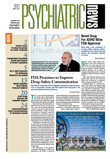The American Academy of Child and Adolescent Psychiatry (AACAP) has issued a new “practice parameter” for evaluating and treating attention-deficit/hyperactivity disorder (ADHD).
Based on a review of more than 5,000 papers published since 1996, the document is a “major statement by the academy on ADHD and how to treat it,” said the paper's lead author, Steven Pliszka, M.D., a professor of psychiatry and chief of the Division of Child and Adolescent Psychiatry at the University of Texas Health Sciences Center in San Antonio.
“A parameter is a detailed discussion of the current state of the science,” said Pliszka in an interview. “It's more specific than a guideline and addresses screening, diagnosis, the best medical and nonmedical treatments, side effects, and patient monitoring systems.”
The ADHD parameter was last revised in 1997, but advances in research and clinical experience make an updated version helpful today, said James McGough, M.D., a professor of clinical psychiatry and director of the ADHD treatment program at the University of California at Los Angeles Semel Institute.
“We now have a greater understanding of the disorder, new clinical trials, new medications, and new long-term drug formulations that are changing the way we treat patients,” said McGough, who was not involved in writing the AACAP document, in an interview with Psychiatric News.
Besides the new developments in treatment, the intervening years have also seen a better understanding of the underlying neurobiology and genetics of ADHD. Genetics is now believed to play an important role in the origins of the disease, said Pliszka. “There's no debate [among psychiatrists] on whether it exists or its neurological basis.”
The practice parameter sets out 13 recommendations, each graded by the level of evidence available to support it. It begins by recommending that screening should be a part of every young patient's mental health assessment, since ADHD is the most common psychiatric disorder of childhood.
Evaluation, and eventually monitoring, should draw on a wide variety of information sources besides the child—parents, teachers, and other caregivers, for example. ADHD depends on a clinical diagnosis drawing upon the patient's and the family's history. Expensive neurological or psychological tests add little or no information to what the clinician learns from interviewing the patient, parents, and teachers and reviewing the“ patient's medical, social, and family history,” according to the guideline, unless ruling out neurological comorbidities is necessary. Neuroimaging, however, has no scientific justification regarding ADHD, said McGough.
Behavioral treatment may be indicated for milder cases or as an adjunct to medication, but the latter has proven safe in most cases. Treatment should always begin with an FDA-approved drug and proceed to off-label agents only if standard drug treatment fails or cannot be tolerated, according to the parameter.
Treatments that fall outside the medical mainstream, like dietary supplements or homeopathy, should not be considered, said McGough.“ Within the ballpark of treatment, you have a lot of flexibility, but anything outside is on the fringe.”
He also concurred with AACAP's recommendation to monitor drug treatment as one would do with other psychotropic medications, although side effects are uncommon. In light of concerns about cardiac side effects, physicians should ask and document information about heart problems with regard to both patients and their families, as they would when clearing a young athlete to play sports.
Patients who have a structural cardiac defect; a history of syncope, fainting while exercising, or a seizure of cardiac origin; or a family history of sudden cardiac death should be referred to a pediatric cardiologist, said McGough.
While primarily intended for child and adolescent psychiatrists, the practice parameter will also be useful for primary care physicians and general psychiatrists, who are frequently called upon to treat ADHD patients in their practices, said Pliszka.
A condensed version of the practice parameter, designed as a pocket card for clinicians, is available from AACAP.
“Practice Parameter for the Assessment and Treatment of Children and Adolescents With Attention-Deficit/Hyperactivity Disorder” is posted at<www.aacap.org/galleries/PracticeParameters/New_ADHD_Parameter.pdf>. Ordering information for the pocket card is posted at<www.aacap.org/cs/root/member_information/practice_information/pocketcards>.▪
